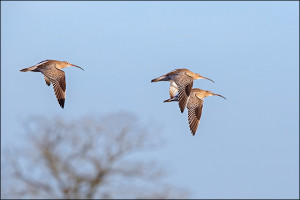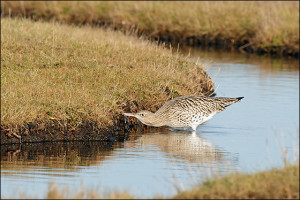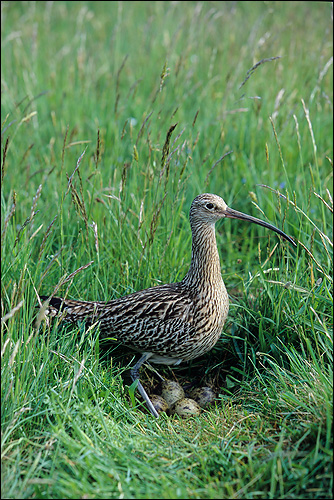Eurasian Curlew (Numenius arquata)
You cannot miss the marvellous slim curved bill of the Curlew – it defines the bird itself. But what is it for? On a simple level the answer is obvious; it allows the Curlew to reach into places that other waders cannot reach, and thus confers upon its owner a competitive advantage when foraging. But it takes a closer look to see just how the shape is advantageous. When the curved bill is poked through a narrow entrance – the burrow of an animal, for example, or the gap between rocks – the tip can investigate a greater surface area than a straight bill could (to appreciate the difference, put your finger inside your mouth, first straight and then bent like a Curlew’s, and try to feel around each time). Another advantage is that, when a curved bill is probed into a soft substrate, such as mud, its turning circle at the tip is much wider than at the tip of a straight bill, so the Curlew can touch-detect prey over a relatively wider volume. Thirdly, the curved bill is slightly better for reaching prey on the surface.
If a curved bill is so useful, then why doesn’t every wader have one? The answer is that the structure has its disadvantages, too. A curved bill is inherently much weaker than a straight bill, and liable to break. So it must be strengthened within by a series of internal struts and thickenings. This may be fine, but it allows for only a narrow passage inside, and the tongue cannot squeeze all the way down. The tongue’s operation is limited to the bill nearest the mouth, so that means that the Curlew can only swallow larger items if they are brought to the surface and tossed about.
Female Curlews have longer bills than males, and they are also larger and heavier-bodied. This means that in the wintertime the two sexes can segregate, where possible, into subtly different niches, the females occupying the muddy intertidal zone and feeding on polychaete worms, crabs and molluscs, the males utilising nearby pastureland and grassland and subsisting on earthworms. The larger females frequently hold feeding territories throughout the non-breeding season, and may return to them year after year.
For breeding the familiar Curlew occupies a wide range of sites in many climatic zones, from the fringes of the Arctic to the steppes of Eastern Europe; these include moorland bogs, uplands and the edge of the tundra. Its only requirements are that that each site provides both damp places and dry patches, and that disturbance is reasonably limited. The nest is placed on the ground, often in an exposed place, but also sometimes upon a tussock.
Male Curlews defend discrete territories upon their arrival in spring, and do so by a stereotyped song flight. It consists of a steep rise on fluttering wings, followed by a slow, parachuting descent with the wings held above the horizontal. It is not much different from many wader routines but its accompaniment, the Curlew’s long, bubbling song, elevates it into an experienced not to be missed. After a slow start the song builds up, little by little, into an ecstatic fluty crescendo, one of the familiar, atmospheric sounds of lonely moorlands.



